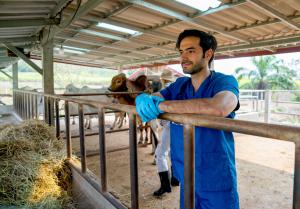TB Herd Statuses & TB Testing Requirements
Information on Tuberculosis Herd Statuses and Testing Requirements for Tuberculosis.
Why has my herd lost its OTF (TB Free) status?

When TB is either suspected or confirmed in a herd it loses its Officially Tuberculosis free (OTF) status.
There are several reasons why a herd might lose its OTF (TB free) status, the most common of which are:
- Reactor /s at the TB Skin.
- One or more animals having two consecutive inconclusive skin test results.
- Lesions detected at routine slaughter.
When any of these occur, the herd will become a TB breakdown herd.
A herd will also lose its OTF status if herd testing becomes overdue.
What does OTS herd status mean?
OTS (Officially Tuberculosis Free Suspended) status means that the TB status of your herd is uncertain. This can be either because TB is suspected but has not been definitively confirmed, or that herd testing is not up to date.
If you have only had 1 reactor which has not confirmed with disease at postmortem or lab testing, your herd status will generally be OTS.
What are the testing requirements for OTS (unconfirmed) breakdowns?
The minimum testing requirement for derestriction of OTS breakdowns is one clear herd test. This herd test is known as an RH1 (Restricted Herd Test 1).
Note: if a positive TB result was first discovered at an individual animal test or at slaughter, rather than at a herd test, an initial RHT herd test may also be required (see RHT section).
What does OTW herd status mean?
OTW (Officially Tuberculosis Withdrawn) means that your herd is being treated as a confirmed TB breakdown.
If any of the following apply your herd will automatically be made an OTW breakdown:
- More than 1 skin test reactor even if no postmortem or lab confirmation
- At least one reactor or LRS with positive postmortem or lab test results
- More than 5 unconfirmed LRS animals
- Any animal with a positive bacteriology (culture) result
What are the testing requirements for OTW (confirmed) breakdowns?
The minimum testing requirement for derestriction of OTS breakdowns is two consecutive clear herd tests. These tests are known as RH1 (Restricted Herd Test 1) and RH2 (Restricted Herd Test 2). These herd tests will usually be carried out a minimum of 60 days apart.
In OTW breakdown herds RH tests are routinely interpreted using severe interpretation. This is to reduce the chance of infected animals being left behind in the herd and to make sure your herd becomes free of infection as soon as possible.
After my herd is derestricted, what TB testing regime will apply to my herd?
After your herd is derestricted, it will not go back immediately to annual testing. Instead it will be subject to “check testing” as follows:
After OTS (unconfirmed) breakdowns:
One CHT (Check Herd test) will be set with a due date of 6 months after derestriction
After OTW (confirmed) breakdowns:
Two Check Herd Tests (CH1 and CH2) will be set for your herd – The first one (CH1) will be set with a due date of 6 months after movement restrictions are lifted, and the second one (CH2) will be set with a due date of 6 months after completion of the CH1
The purpose of Check Herd testing is to check that no infection has been left behind and to make sure that any original cause of infection has not resulted in the infection of more animals in your herd.
What is an RHT / stabilising herd test and why is it important?
Most infected animals are identified at herd tests, but when a breakdown begins with a LRS or an animal testing positive at an individual animal test, the status of the rest of the herd is unknown if the herd has not recently completed a full herd test.
For this reason an immediate stabilising test (RHT) may be set if the herd has not recently been tested. The purpose of an RHT is to:
- establish the extent of infection in the rest of the herd,
- remove infected animals as early as possible, and
- prevent further spread of infection to healthy animals.
Occasionally, an RHT may be a part test, carried out on the highest risk groups in a herd. Herd-keepers are advised to complete an RHT at the earliest opportunity to establish the disease status of the herd. Failure to promptly complete an RHT may delay detection of further affected animals and prolong the breakdown.
RHTs are extremely valuable surveillance tests for the Department and affected herd-keepers. In 2023, approximately 30% of RHT tests revealed at least one reactor. This shows the importance of RHT tests in picking up infected animals as soon as possible, therefore reducing further spread of disease within the herd.
What animals need to be tested during a TB breakdown?
As for any other herd test, calves less than 6 weeks old are usually exempt from testing, even if they are not homebred.
Very occasionally there may be a need to test calves less than 6 weeks of age. If this is the case, you will be informed accordingly. The vet carrying out your TB test should not test calves under 42 days on day 1 of the test unless the local DAERA office has advised that they should be tested.
For blood testing you will be advised which groups of animals are to be tested and calves < 6 months are not eligible for testing.